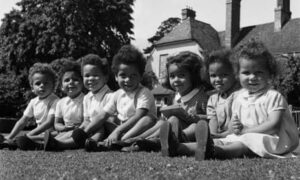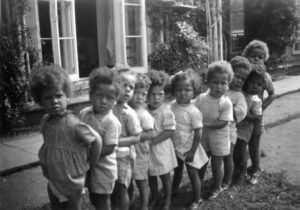Tucked away in the scenic landscapes of Exmoor in Somerset, UK, lies Holnicote House, a property that once held a significant yet largely overlooked chapter in British history. Known today as a hotel, Holnicote House was once home to Britain’s first mixed-race orphanage, where children born to white British mothers and African American GIs after World War II were raised. The legacy of this orphanage, however, is not widely recognized, despite its impact on the racial landscape of post-war Britain.
Carol Edwards’ Connection to Holnicote House
One of the former residents of Holnicote House, Carol Edwards, recently revisited the property, sparking conversations about its forgotten history. During a tour of the estate, Edwards, now 79, revealed that she had spent the first five years of her life at the orphanage, a detail omitted from the tour guide’s narrative of the estate’s 500-year history. Edwards, along with 25 other children, was part of a unique group born to interracial unions at a time when such relationships were not widely accepted.
The “Brown Babies” and the Rise in the Black British Population
These children, referred to as “brown babies” by U.S. newspapers, were born during a period of immense cultural and racial tension. Roughly 2,000 mixed-race children were born in the UK during the war, at a time when the country’s Black population numbered between 7,000 and 10,000. The existence of these children marked a 25% increase in the Black British population, but despite their significant presence, many were abandoned or put up for adoption, with Holnicote House being the only orphanage specifically created to care for them.
Holnicote House: A Place of Care and Love
Edwards reflects on her time at Holnicote House with fondness, describing it as a place of care and love. “We were all treated the same and never made to feel different,” she said. “I feel quite privileged to have spent my first five years there. I think I was one of the lucky ones.” However, for many others, life was far from easy. Being both mixed race and born outside of marriage, many children faced a double stigma. Dr. Chamion Caballero, co-founder of the Mixed Museum, explained that these children were often seen as a social problem, isolated in predominantly white rural areas where they experienced racism and had little connection to Black communities.
Also, read; Former MTV Host, Ananda Lewis Reveals Her Breast Cancer Has Advanced to Stage 4
Racial Tensions Amidst World War II
The cultural clash that surrounded the birth of these children was rooted in the racial dynamics of the U.S. military, which remained segregated during World War II. Approximately 240,000 Black GIs passed through Britain, many of them assigned to non-combat roles due to racial segregation. Despite this, Black soldiers were generally well-received by British locals, who found them more polite and friendly than their white counterparts. However, attitudes shifted when interracial relationships resulted in children, revealing the deeper societal prejudices that remained. “Great to be friends, great to be allies. Don’t necessarily want you as a son-in-law,” was a sentiment many British families held.
Adoption and Racial Identity
Both Carol Edwards and another former Holnicote resident, Ann Evans, shared the experience of being adopted by white families after leaving the orphanage. For Edwards, her journey to understanding her racial identity came through music, discovering a sense of belonging in the voices of Black artists like Sarah Vaughan and Nina Simone. Evans, who was adopted by a Welsh family, also faced racial prejudice but found strength in her adoptive family’s unwavering support.
Reconnecting with Their Roots
Over time, both women sought to reconnect with their biological families, each finding varying levels of success. Yet, their shared experiences at Holnicote House, Britain’s first mixed-race orphanage, remain an integral part of their personal histories.
Preserving Holnicote House’s Forgotten Legacy
During her recent visit to Holnicote House, Edwards pointed out to the new owner that there were no visible photographs or references to the estate’s time as an orphanage for mixed-race children. In response, the owner promised to correct this oversight, ensuring that this forgotten chapter of British history is acknowledged and preserved for future generations.
Conclusion
The story of Holnicote House offers a poignant reflection on Britain’s complex relationship with race and identity. It is a story of love, resilience, and the challenges faced by those caught in the crosshairs of cultural and racial tensions. As we move forward, it is crucial to remember these histories and ensure that the voices of those who lived through them are heard.






